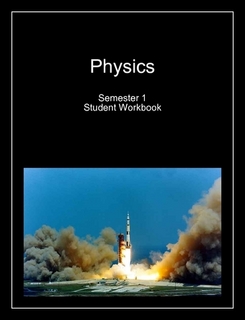|
|
Physics

|
|
|
Description
This course is a high school physics course with lab exercises. It will cover the topics normally covered in a high school physics. This course is one of the three core high school science classes: Physics, Chemistry, and Biology. Students should have completed a course in Algebra 1 before enrolling in Physics. A detailed course outline is shown below.
|
Lecture and Class Time
Class time will primarily be spent on instruction. Students should bring their Student Workbook to each class, or a printout of the pages for that week. The pages of the workbook are identical to the instructor's lecture notes, except the student version has the solutions and answers deleted. During the lecture the students take notes and solve the example problems in the workbook.
Videos of the lectures are also available online, and these videos go through the same lecture notes, point by point. Students use the videos to cover any material that time constraints did not permit us to cover in our weekly class. Or, if a student misses a class or needs to review the material, all of the course content is available online. It is possible to take the entire course online via distance learning, and many students have done so.
|
Textbook
The textbook is no longer required for this class. All of the course content comes from the lectures and the Student Workbook. The course was originally based on the book Physics by Douglas Giancoli, 5th edition, published by Prentice Hall. This is a text used by many high schools and some colleges. If needed, a copy of the textbook can be provided as a reference and as a source of additional practice problems.
|
Homework, Tests and Grades
Students will be given specific assignments to complete each week. Assignments will consist of Practice Problems from the workbook, instructional videos online, and written assignments.
In this class there is a distinction between Practice Problems and Homework Problems. Practice Problems are found in the workbook, and students check their answers with the solutions provided. Homework assignments and tests are printed from the website, completed, and turned in for a grade.
To maximize instructional time in class, tests will be given at home. One final exam for each semester will be taken in class at the end of each semester. Students will receive a numerical grade for each semester and for the year. The grade is calculated based on tests, graded homework and the final exams.
|
Difficulty Level
Not all students require the same pace and difficulty level. Some may need or prefer a class that is more challenging and at a faster pace, while some may desire a class that is not accelerated. This class is offered simultaneously on two difficulty levels, regular and honors. The lectures are the same for both. The honors students will have additional homework problems that are more difficult, and on each test will have an extra page with more challenging questions. Note that the honors class is not an AP class. It is simply a more challenging version of the same course. The goal is for the classes to closely correspond to "Regular Physics" and "Honors Physics" classes at a good private school. Students may decide whether they will take the standard or honors version of the course after completing one or two chapters.
|
Internet Access
Access to a computer with a high speed internet connection is strongly recommended. Instructional materials such as lecture videos, lecture notes, homework assignments and tests will be available over the internet. Graded assignments and tests may also be returned via email in order to provide more timely feedback. Progress reports will be put on the website and updated regularly.
|
The Instructor
Derek Owens graduated from Duke University in 1988 with a degree in mechanical engineering and
physics. He taught physics, honors physics, AP Physics, and AP computer science at The Westminster Schools
in Atlanta, GA from 1988-2000. He worked at the TIP program at Duke for two years, teaching physics and
heading the Satellite Science Program. He received a National Science Foundation scholarship and
studied history and philosophy of science at L'Abri Fellowship in England. He worked as a software
developer for six years before returning to teaching. Since 2006, he has been a full time teacher for
homeschoolers in the Atlanta area. He and his wife Amor and their two children Claire and David
attend Dunwoody Community Church, a non-denominational church near their home in Norcross, GA.
|
Course Outline
These topics comprise the material normally taught in a high school Physics course.
-
Chapter 1: Introduction
What is Physics?
What is a scientific theory?
Units of measurement;
Scientific Notation;
Converting Units;
Measurement;
Significant Figures
-
Chapter 2: Motion in One Dimension
Position and Displacement;
Speed and Velocity;
Vectors and Scalars;
Reference Frames;
Graphing Position versus Time;
Instantaneous Velocity;
Acceleration;
Equations for Accelerated Motion;
Velocity versus Time Graphs;
Acceleration versus Time Graphs;
Falling Bodies, Galileo;
Terminal Velocity
-
Chapter 3: Motion in Two Dimensions
Vectors and Vector Math;
Relative Velocity;
Basic Trigonometry;
Resolving a Vector into Components;
Projectile Motion
-
Chapter 4: Newton's Laws
Force;
The Law of Inertia;
Mass;
Newton's Second Law;
The Law of Action and Reaction;
Weight;
Friction;
-
Chapter 5: Work and Energy
Work Kinetic Energy;
Potential Energy;
The Law of Conservation of Energy;
Power
-
Chapter 6: Momentum
Linear Momentum;
The Law of Conservation of Momentum;
Angular Momentum
-
Chapter 7: Circular Motion
Uniform Circular Motion;
Centripetal Acceleration and Centripetal Force;
Applications of Circular Motion
-
Chapter 8: Gravity
Newton's Law of Universal Gravitation;
Gravity Near the Earth's Surface;
Satellites and Weightlessness, Circular Orbits;
Geosynchronous Orbits;
Theories of Planetary Orbits
-
Chapter 9: Temperature and Heat
Atoms;
Temperature;
Pressure;
Thermal Expansion;
The Gas Laws;
Absolute Zero;
The Mechanical Equivalent of Heat;
Specific Heat;
Entropy
-
Chapter 10: Waves and Wave Motion
Oscillations;
Resonance;
Interference, Standing Waves;
The Equation for Wave Motion;
Sound Waves;
The Doppler Effect;
Shock Waves and the Sonic Boom;
The Doppler Effect with Light Waves;
Reflection;
Refraction, Snell's Law;
Lenses
-
Chapter 11: Optics
Reflection;
Refraction, Snell's Law;
Lenses
-
Chapter 12: Electricity
Static Electricity;
Conductors and Insulators;
Lightning;
Coulomb's Law;
The Electric Field, Michael Faraday;
Electric Field Lines;
Electric Potential and Potential Difference;
Simple Circuits;
Capacitors
-
Chapter 13: Electric Circuits
The Electric Battery;
Electric Current;
Ohm's Law;
Electrical Resistance;
Electric Power;
Alternating Current;
Series and Parallel Circuits;
Magnetism;
Electric Motors;
Power Generation
|
|
|
|
